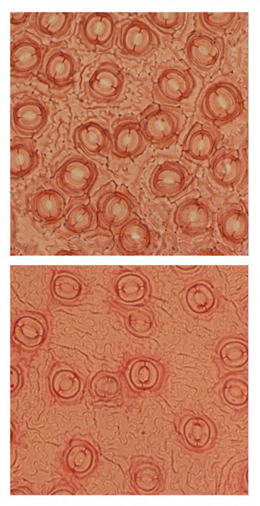As if ocean acidification and a warming world weren’t enough, researchers have outlined another way in which carbon emissions are impacting the planet. A new study shows that higher carbon dioxide levels in the atmosphere have taken a toll on how much water vapor plants release, potentially impacting the rainfall and groundwater sources. A study in the Proceedings of the National Academy of Sciences (PNAS) has found that carbon dioxide levels over the past 150 years has reduced plants’ spores, called stomata, by over one third (34%). This is important because stomata take in oxygen and carbon dioxide and release water vapor in a process dubbed ‘transpiration’. Less stomata means less water driven into the atmosphere.
 Stomata are structures that allow plants to exchange gases with the air. Contemporary plants in Florida (bottom) have fewer stomata than their ancestors did a few decades ago (top). Photo by: Emmy Lammertsma. |
“The increase in carbon dioxide by about 100 parts per million has had a profound effect on the number of stomata and, to a lesser extent, the size of the stomata,” explains co-authors David Dilcher of Indiana University Bloomington in a press release. “Our analysis of that structural change shows there’s been a huge reduction in the release of water to the atmosphere.”
Gathering a variety of plant species from Florida researchers looked at the stomata patterns going back 150 years. To capture century-old stomata the researchers looked to a Florida herbarium and dug out plants buried in peat at the time of the American Civil War.
Water released from plants through transpiration makes up around 10% of water vapor in the atmosphere. According to researchers, a loss in transpiration volume could impact rainfall and even the amount of groundwater.
“The carbon cycle is important, but so is the water cycle. If transpiration decreases, there may be more moisture in the ground at first, but if there’s less rainfall that may mean there’s less moisture in ground eventually,” Dilcher says, adding that, “this is part of the hyrdrogeologic cycle. Land plants are a crucially important part of it.”
Having discovered that carbon levels impacted plant stomata, the researchers created a model showing that stomata could be reduced by 50% if current carbon dioxide levels double.
Related articles
(03/21/2011) The UN-backed Collaborative Partnership on Forests (CPF) is urging nations to conserve their forests in a bid to mitigate rising water scarcity problem.
Groundbreaking research shows that rainforests and coral reefs create rainfall #BAD10
(10/15/2010) Coral reefs and rainforests seem to have little in common beyond the fact that they are both hotspots of diversity, yet groundbreaking research is showing how these different ecosystems—when intact—may actually seed clouds and produce rainfall.
Drought crippling southwest China, millions without drinking water
(03/22/2010) Over 50 million people are affected by a severe drought in southwest China, according to Xinhua, the nation’s state media. The lack of rain and unseasonably high temperatures has also left 16 million people without easy access to drinking water.














